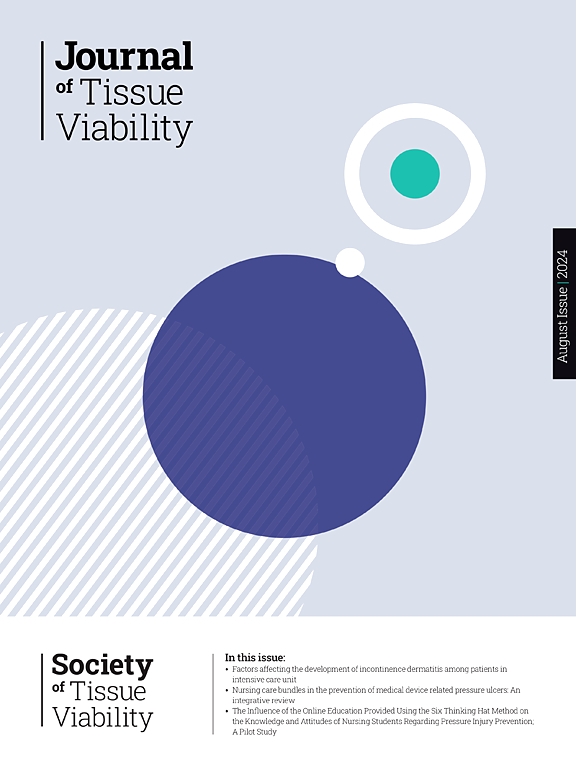压力损伤阶段的评价方法:系统回顾和荟萃分析
IF 2.4
3区 医学
Q2 DERMATOLOGY
引用次数: 0
摘要
背景:压力性损伤在临床环境中很普遍,需要精确的分期以获得最佳护理。传统视觉评估的主观性和不精确性引发了基于先进技术的评估工具的创造。目的系统评价压伤分期方法,分析其评价结果,为临床实践提供参考。设计系统回顾和荟萃分析。数据来源:pubmed, Embase, Cochrane Library, Web of Science, CINAHL,手工检索学术期刊和会议记录。方法本研究于2024年4月对数据库进行系统检索,利用Endnote X9记录研究结果。两名审稿人独立提取数据并使用QUADAS-2工具评估其质量。Meta-disc上进行的荟萃分析侧重于AUC、敏感性和特异性等指标。采用Cochran’s Q和I2检验评估研究间的异质性。本综述筛选了15312篇文章,最终纳入了15项研究。这些研究描述了压力损伤分期的方法,包括视觉评估、29个机器学习模型和人类模型综合评估。传统的目视评估准确率较低,且存在显著的变异性。meta分析纳入了8项研究,涉及24个机器学习模型,显示出非常高的准确性,AUC为0.93,综合敏感性、特异性和诊断优势比分别为0.81、0.87和20.48。结论本综述强调了机器学习在诊断压力性损伤方面的优势,与传统方法相比,机器学习具有更高的准确性。将临床专业知识与机器学习相结合,可以提高医疗服务质量和效率。普洛斯彼罗注册号crd42023462951。普洛斯彼罗注册linkcrd.york.ac.uk/prospero/display_record.php?ID=CRD42023462951。本文章由计算机程序翻译,如有差异,请以英文原文为准。
Evaluation methods of pressure injury stages: A systematic review and meta-analysis
Background
Pressure injury is prevalent in clinical settings and demands precise staging for optimal care. Subjectivity and imprecision in traditional visual assessments have sparked the creation of advanced technology-based evaluation tools.
Aims
To systematically assess pressure injury staging methods, analyze their evaluation results, and provide reference for clinical practice.
Design
Systematic review and meta-analysis.
Data sources
PubMed, Embase, Cochrane Library, Web of Science, CINAHL, and manual searches of academic journals and conference proceedings were utilized.
Methods
The study conducted a systematic search of databases in April 2024, utilizing Endnote X9 to document findings. Two reviewers independently extracted data and evaluated its quality using the QUADAS-2 tool. The meta-analysis, conducted in Meta-disc, focused on metrics such as AUC, sensitivity, and specificity. Heterogeneity among the studies was assessed using Cochran's Q and I2 tests.
Results
This review screened 15312 articles and ultimately included 15 studies. These studies described methods for pressure injury staging, including visual assessment, 29 machine learning models, and human-model integrated evaluation. The accuracy of traditional visual assessment was relatively low and showed significant variability. Eight studies involving 24 machine learning models were included in the meta-analysis, demonstrating significantly high accuracy, with an AUC of 0.93, and the combined sensitivity, specificity, and diagnostic odds ratio were 0.81, 0.87, and 20.48, respectively.
Conclusion
The review underscores the advantages of machine learning in diagnosing pressure injuries, offering higher accuracy over traditional methods. Integrating clinical expertise with machine learning enhances medical service quality and efficiency.
Prospero registration number
CRD42023462951.
Prospero registration link
crd.york.ac.uk/prospero/display_record.php?ID=CRD42023462951.
求助全文
通过发布文献求助,成功后即可免费获取论文全文。
去求助
来源期刊

Journal of tissue viability
DERMATOLOGY-NURSING
CiteScore
3.80
自引率
16.00%
发文量
110
审稿时长
>12 weeks
期刊介绍:
The Journal of Tissue Viability is the official publication of the Tissue Viability Society and is a quarterly journal concerned with all aspects of the occurrence and treatment of wounds, ulcers and pressure sores including patient care, pain, nutrition, wound healing, research, prevention, mobility, social problems and management.
The Journal particularly encourages papers covering skin and skin wounds but will consider articles that discuss injury in any tissue. Articles that stress the multi-professional nature of tissue viability are especially welcome. We seek to encourage new authors as well as well-established contributors to the field - one aim of the journal is to enable all participants in tissue viability to share information with colleagues.
 求助内容:
求助内容: 应助结果提醒方式:
应助结果提醒方式:


